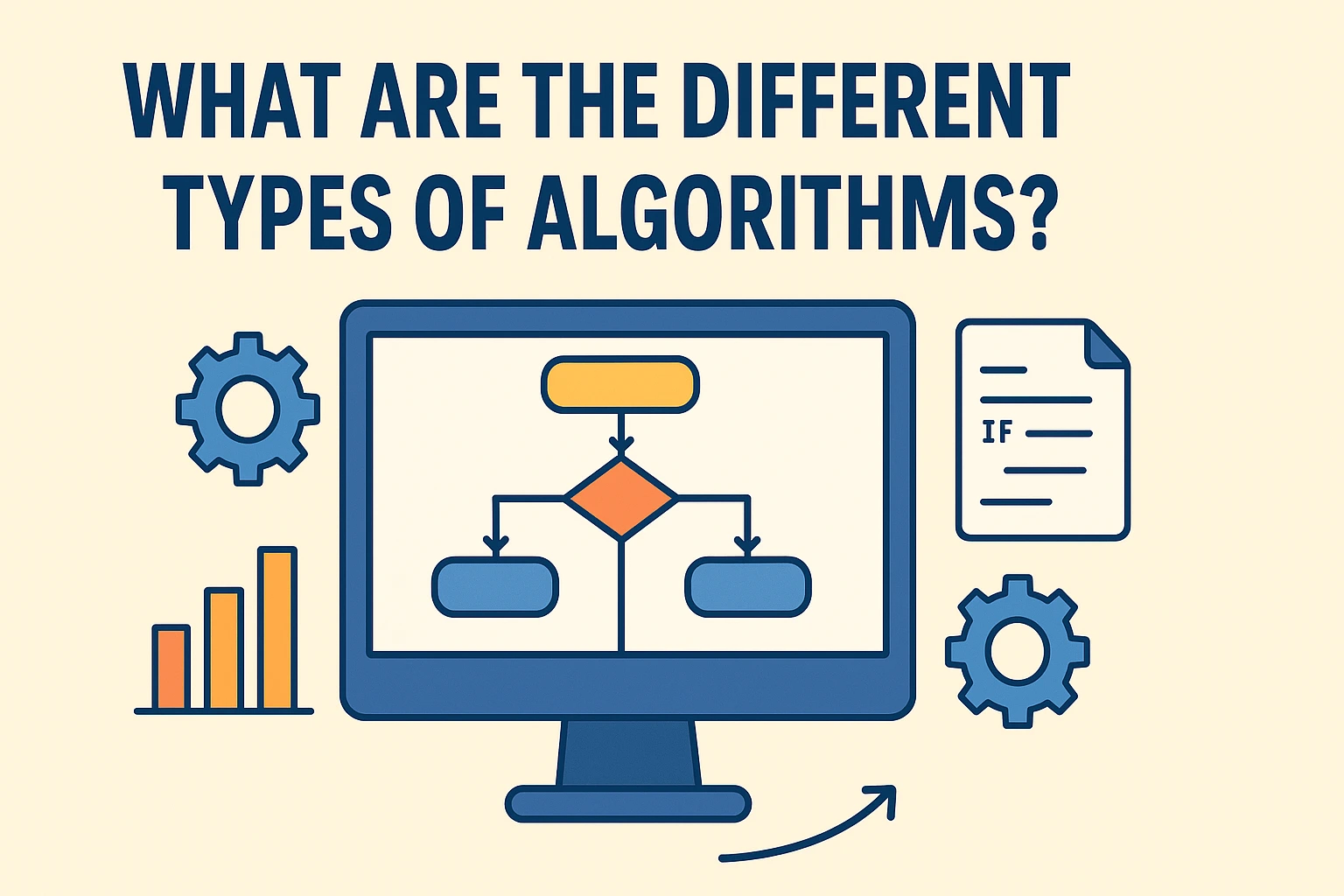Algorithms are included in nearly all of our tools. They make search engines work, as well as banking apps. But what are the types of algorithms and the way they work? Let us simplify it.
What is an Algorithm?
An algorithm is a set of steps. It provides a definite way of solving a task. Think of it like a recipe. A recipe is a list of the steps you have to follow to prepare food. Computers do the same with algorithms.

Why Do We Need Algorithms?
Computers are assisted by algorithms in solving problems. They save time, make less mistakes and bring order. Without them, even such basic tasks as sorting names or route finding would be too long.
Main Types of Algorithms
Algorithms are of various types. Each type has a special role. We will take a glance at the most popular ones.
Table of Contents
1. Sorting Algorithms
Sorting refers to organizing. Sorting algorithms separate numbers, words or data.
Examples:
- Bubble Sort: Compares two elements and exchanges them in case they are out of order.
- Merge Sort: Divides data into small segments, sorts them and recombines.
- Quick Sort: Selects a point, and sorts smaller sections around it.
Sorting is useful in the search, ranking, and organization of files.

2. Searching Algorithms
Data can be found quickly with the assistance of search algorithms. They search within lists, files or databases.
Examples:
Linear Search: Scans the items until it locates a match.
Binary search: is efficient in that it reduces the search space by half at each step.
They are needed to drive functions in applications such as e-commerce filtering of products and search engines.
3.Greedy Algorithms
Greedy algorithms take the optimal decision at every step. They aim for a quick solution.
Examples:
- Coin Change Problem: The largest coin is picked first in order to get to a sum.
- Kruskal Algorithm: Minimum path in a network.
Greedy techniques are not necessarily the best answers, but they are quick.
4. Dynamic Programming Algorithms.
Dynamic programming divides large problems into small ones. It records the outcome to prevent duplication of work.
Examples:
- Fibonacci Numbers: Stores previous numbers to accelerate computation.
- Shortest Path (Bellman-Ford, Floyd-Warshall) Finds the shortest paths in maps.
This is the most effective type of problem when issues are overlapping and recurring.
5. Divide and Conquer Algorithms.
This kind breaks down issues into segments. It breaks down the components, and then glues them together to provide the solution.
Examples:
Merge Sort: Separates and combines information.
Binary Search: This is a very fast algorithm that reduces data by half till the target is located.
It is not complex and yet powerful when it comes to huge tasks.
6. Recursive Algorithms
Recursion refers to a self-calling method. Recursive algorithms approach the solution of problems step by step until the base case.
Examples:
- Factorial: Composes of smaller multiplications.
- Tower of Hanoi: Places disks in between rods based on rules.
Recursion is cool, however, it can be slow when not done well.
7. Backtracking Algorithms
Backtracking examines every option. When one of the paths fails, it reinvents another.
Examples:
- Sudoku Solver: Attempts numbers, backtracks on error.
- N-Queens Problem: Position the queens on a chessboard without attack.
It is a method that is usually used in puzzle solving, route finding and decision making.
8. Hashing Algorithms
Fixed short codes represent changes in data. It renders storage and searching quick.
Examples:
- Hash Tables: Data structures that are stored to provide fast access.
Password Storage: Transforms passwords into security hash values.
Hashing is very important in securing and maintaining databases.
9.Graph Algorithms
Network algorithms deal with graphs. A graph is a collection of points that are connected by lines.
Examples:
- Dijkstra Algorithm: This algorithm is used to determine the shortest path between two points.
- Prims Algorithm: Constructs a minimum network out of nodes.
They find their application in maps, social media, and network design.

10. Machine Learning Algorithms.
Such algorithms are data learners. They get better with time without set rules.
Examples:
Decision Trees: Division of data into definite decisions.
Neural Networks: Can be thought of as a brain searching patterns.
K-Means Clustering: It is used to cluster items according to their similarities.
Machine learning employs numerous kinds of algorithms in combination with intelligent outcomes.
Real-Life Uses of Algorithms
- Search Engines: Ranking and sorting are used to display results.
- GPS Apps: Shortest path using graph algorithms.
- E-commerce Sites: Search and sort product listing.
- Banking Systems: Hashing is used to protect user information.
- Games: Backtracking and decision making algorithms.

How to Learn Algorithms
Start simple. First learn sorting and searching. Do step-by-step coding practice. Then go to graph and dynamic programming.
Numerous free tools are available in the online world. Attempt to code websites, open-source applications, or basic applications.
SEO View: Why Should You write about the Kinds of Algorithms?
Types of algorithms are a popular search term. Numerous students, coders and job seekers seek easy answers. You access more readers by writing in simple language.
Keep it simple, provide real life examples and add common keywords. Search engines prefer clear and content that offers real values.
Final Thoughts
Algorithms might seem difficult, yet it is merely a series of steps to resolve problems. The knowledge of the principal kinds of algorithms lets you know how computers think.
These are sorting, searching, greedy algorithms, dynamic programming, and machine learning and only a starting point. They are used in almost every tool, each type of them has its role.
It is easier and smarter to learn them step by step.
Frequently Asked Questions For The Different types Of Algorithms
Q1: What is an algorithm?
An algorithm is a code of instructions to address a problem or a task.
Q2: What are the number of different types of algorithms?
Several but popular are sorting, searching, greedy, dynamic and machine learning algorithms.
Q3: What algorithm is applied to shortest paths?
Shortest path graph algorithms such as Dijkstra or Bellman-Ford.
Q4: Can a beginner learn algorithms?
Yes. Simple sorting and searching should be used first, and then advanced ones should be introduced gradually.


1 thought on “What Are The Different types Of Algorithms?”